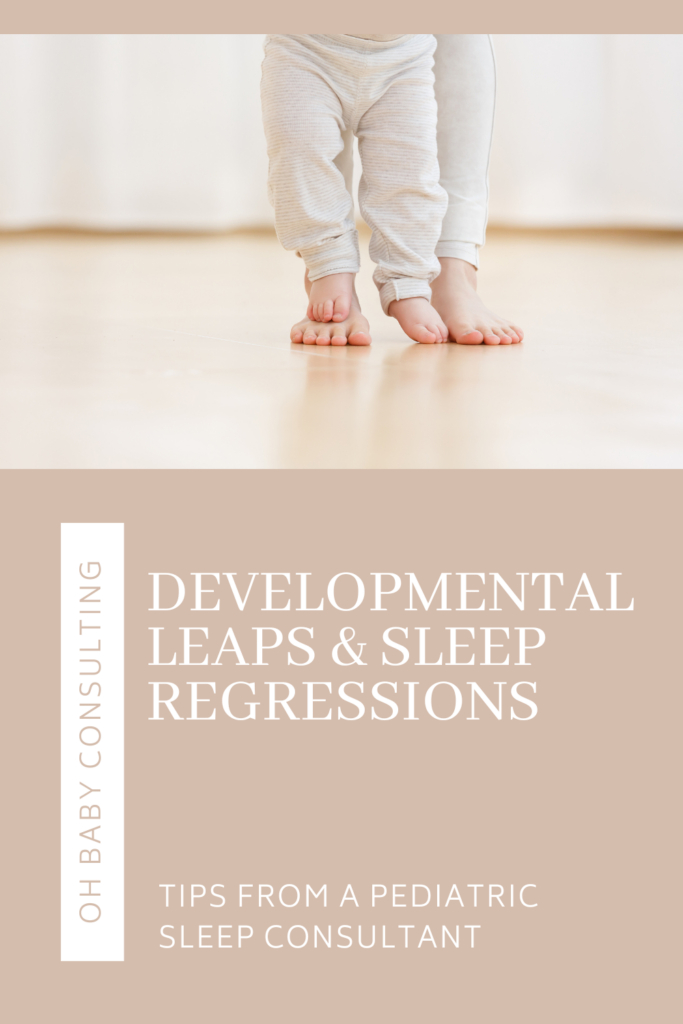Sleep regressions.
I’m pretty sure that the most Googled question ever is, “Is there a(n) [insert any month here] sleep regression?”
With milestone-tracking apps and endless information about baby “leaps”, I want to break down what sleep regressions truly are and how to handle them.
What are sleep regressions?
A regression, by definition, is “a return to a former or less developed state” and when we think of it in the context of sleep, we’re usually talking about a child who has been falling asleep easily, sleeping through the night, and napping predictably who is all of the sudden just… not anymore.
Sleep regressions are not prescribed and predetermined times or “leap periods” where your child’s sleep is automatically going to/guaranteed to suffer.
Sleep regressions are normal parts of development that occur at different time points for different reasons in different children.
While it is normal for even the best sleepers to have off nights from time to time (children are humans, not robots) regressions are often considered to be more prolonged periods of disrupted sleep, usually lasting from several days to several weeks.
Aside from illness & teething, developmental milestones are the most common reason why we see sleep regressions occur.
The relationship between sleep and development
To your baby, learning to roll over, crawl, walk, or talk is a huge, life-altering achievement. When working on mastering such big skills, their brains & body are biologically driven to want to practice them over and over: in the morning, in the afternoon, and at bedtime & in the middle of the night. This excitement and tenacity can make it a little more difficult for them to fall asleep at naps or bedtime and get back to sleep in the middle of the night. It’s like the novelty of the newness is competing with sleep for brain space…and novelty is always going to win.
Milestone achievements – or “leaps” as they’ve become known – happen all throughout childhood. Whether it’s your four-month-old learning to roll over, your six-month-old learning to crawl, your nine-month-old pulling to stand, or your twelve-month-old taking their first independent steps, your baby’s development is in a constant state of flux for the first several months of their little life.
But just like we see general trends but individual difference in when & how babies meet their milestones, we also see general trends and individual differences in when & how sleep is disrupted because of them.
Thus, we should not think about sleep regressions as prescribed or predetermined periods where sleep is guaranteed to suck (and why I’m not a fan of the Wonder Weeks.)
How to handle sleep regressions
The important thing to remember is that development-related sleep disruptions are not permanent. But oftentimes, in trying to get baby’s sleep back on track, parents tend to lose consistency and get away from the habits & expectations that had been working for them. They’ll move bedtimes around, start rocking or feeding baby back to sleep, change up the bedtime routine, anything they think might help. Inevitably, these things don’t actually help much and can even make things more confusing for everyone in the long run.
The best advice I can give you is to stay the course. Disruptions due to milestone leaps should only last for a couple weeks at most (unless we’re talking about the biological changes that a baby undergoes during the 4-month sleep regression). Anything beyond that and there might be more to the story than just skill-building.
But though my umbrella advice is do nothing, change nothing, I know that can feel totally unhelpful. So here are 6 tips for you as you’re riding out any sleep regression.
- DON’T PANIC!
A night of bad sleep or a weekend of crap naps doesn’t mean that sleep skills have crumbled. Just like we as adults go through periods where our sleep isn’t the best, babies are the same. - DON’T ASSUME…
…that your child has suddenly lost the ability to sleep independently. They haven’t. - PRACTICE
The quicker your child is able to master whatever it is they are working on, the quicker it will stop disrupting sleep. If you notice that your child has started working on something new, get lots of practice in during the day so it doesn’t start to disrupt your night! - GIVE SPACE
When your child is suddenly rolling in the crib, sitting when they’re supposed to be sleeping, or standing up immediately when you leave the room, it can be confusing to know when or if to help them or intervene. My answer is usually, “don’t”. A good rule of thumb is that as long as your little one is safe, you can give them some practice figuring out a comfortable sleep position on their own.
Rolling: Most pediatricians will tell you that when your baby is able to purposefully and intentionally roll themselves both ways, they are okay to sleep on their tummy. (Of course, run this by your pediatrician first.) However, once they start rolling, it is important to make sure your baby is no longer swaddled.
Sitting: If your child has started sitting up at bedtime or in the middle of the night and will not lay down even as they are falling asleep, try not to intervene. Your child will quickly learn that it is much more comfortable to sleep laying down than it is to sleep sitting up. If your child falls asleep sitting up, you can go lay them down once they are in a deep enough sleep but know that you run the risk of waking them up and having to start all over again. During the day, the more you can help them practice laying down from a sitting position, the sooner your child will be able to do this on their own in the middle of the night.
Standing: The same goes for standing. If you are uncomfortable with your child standing in their crib, you can certainly go in and lay them down every so often, but to be careful that this interaction does not turn into a game. I stand up, mommy comes and lays me back down. What a fun way to play with her at 3am! However, if ever you notice that your child is falling asleep while they are standing, please go in and intervene.
Use your best judgment here and remember that uncomfortable is different than unsafe. - DON’T START ANY NEW HABITS
Don’t start any new habits that you don’t intend to continue for the long term. I’m not saying you can’t check in or comfort if needed, but be mindful of how capable your child has been up to this point & avoid over-helping. When we change sleep expectations drastically, it’s easy to lose confidence in our child’s ability to sleep independently. Then what began as a temporary regression that may have only lasted a week or two turns into months-long sleep struggles. - ASK FOR HELP
Oftentimes when we get bogged down in the nitty gritty of our current situation, it can be hard to see the forest through the trees. If you want a second set of eyes and another brain, I have those things! Book a support call for a personalized Q&A session with me!
These phases will be challenging, and it may feel at times like one skill is mastered just in time for another one to start developing, but hang in there! Support your child’s brain and body as they discover their new skills and honor their need for quality sleep as they grow. And remember that these are just temporary phases and you’ll emerge on the other side with an older, bolder, more skilled child!
If you’re struggling to get back on track after a regression wreaked havoc on your child’s sleep, I can help! Set up a complimentary sleep evaluation and let’s chat about restoring peace into your nights!














